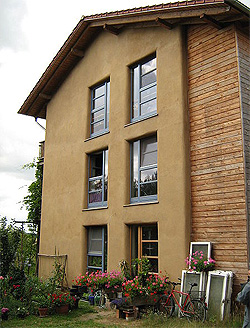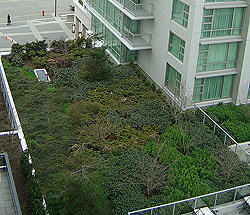Sustainable Development in Neighbourhoods Homes and Businesses
Objective C3: Incorporate Sustainable Development into the Design of Neighbourhoods, Homes and Businesses
The following actions are needed to complete this objective:
- Develop a Green Building Standard for new development.
- Advertise the Green Building Standard to homeowners and developers, as legislation and building codes allow. The guide may include the consideration of:
- Green roofs/cool roofs
- Low impact development (rain gardens, bioswales, permeable pavement, etc.)
- Rainwater retention
- Energy efficiency
- Active transportation facilities
- Underground parking
- Windows in office buildings which can be opened
- Improved temperature control systems
- Alternative energy sources
- Access to public transit
- Work with developers to encourage best practices and the integration of the ideas listed above. Create incentives for sustainable design by builders and demand for sustainable homes (and businesses owners) through the development of an education campaign about the advantages of scoring high on the Green Building Standard (i.e. energy and cost saving)
- Identify best practices to improve heat resilience in homes and businesses (e.g. options for passive cooling, shading, etc.).
- As part of the Official Plan review, work with small businesses to improve streetscapes and interactivity (encouraging local community development)
- Identify and take advantage of provincial and federal programs for funding and best practices.
- Create incentives for businesses and neighbourhood development which incorporate age-friendly facility design and accessible, safe routes to and from homes, schools and businesses.
- Work with developers to maintain as many trees as possible.
- Expand the public right-of-way to enhance the opportunities for tree plantings, stormwater management, active transportation options, and urban heat island mitigation.
These indicators show the progress the City is making to achieve this objective:
- Green Building Standard
- Number of buildings participating in the Green Building Standard
Sustainable Construction Indicator

Sustainable construction is about building a better quality of life. Developers, architects and builders committed to sustainable design will think about all aspects of construction and ongoing operations of a facility, including:
- Sustainable site development
- Water efficiency
- Energy efficiency
- Materials selection
- Indoor environmental quality
The Canada Green Building Council is responsible for the Leadership in Energy and Environmental Design (LEED) Green Building Rating System TM in Canada. This program encourages and accelerates global adoption of sustainable green building and development practices through the creation and implementation of universally understood and accepted tools and performance criteria.
LEED is a third-party certification program and an internationally accepted benchmark for the design, construction and operation of high performance green buildings. It provides building owners and operators the tools they need to have an immediate and measurable impact on their building's performance.
A cost-benefit study for sustainable designs was completed by the City of Toronto in 2008. The findings indicated that, although sustainable design and construction may represent an initial premium of 2 to 7 percent over conventional buildings, an average energy and water savings of 40 and 25 percent respectively was achieved. With other government incentive programs, the payback period for sustainable buildings was almost immediate. Another finding of the study was that people were reported as healthier and more productive in sustainable buildings than in conventional buildings by 20 to 30 percent. The full cost-benefit study is available on the City of Toronto's website.
How's the City of Windsor doing?
Currently, there are thirteen projects registered on the Canada Green Building Council as LEED projects.
| Project | Registration Date | Certification Date | Certification Level |
|---|---|---|---|
| Gordie How International Bridge | August 2018 | Not Yet Certified | Not Yet Certified |
| University of Windsor (441 University Avenue) |
September 2016 | October 2021 | Gold |
| Devonshire Mall Common Area | October 2016 | June 2022 | Gold |
| Former Target, Devonshire Mall | February 2013 | May 2013 | LEED for Retail |
| La Bella Strada | September 2011 | Not Yet Certified |
Not Yet Certified |
| HMCS Hunter | April 2010 | July 2016 | Gold |
| City of Windsor Fire Hall 7 | January 2010 | August 2015 | Silver |
| Ojibway Nature Centre | December 2009 | October 2012 | Silver |
| Confidential Project | May 2009 | August 2015 | Silver |
| Union Gas Windsor District Office | January 2008 | April 2011 | Gold |
| Dr. David Suzuki Public School | June 2007 | November 2011 | Platinum |
| Ecole Secondaire de Windsor | March 2007 | May 2013 | Gold |
| Toldo Medical Education Building | November 2006 | February 2014 | Silver |
| Rosewater Estates Building B | September 2021 | Not Yet Certified | Not Yet Certified |
| Rosewater Estates Building C | October 2021 | Not Yet Certified | Not Yet Certified |
| Rosewater Estates Building D | October 2021 | Not Yet Certified | Not Yet Certified |
| 477 Pelissier | July 2021 | Not Yet Certified | Not Yet Certified |
To earn LEED certification, the applicant project must satisfy all of the prerequisites and a minimum number of points to attain a LEED rating level upon completion of the project.
What is the City of Windsor doing to encourage Sustainable Construction?

The City of Windsor is in the process of preparing a new Site Plan Control Manual that will set out standards that require more sustainable development practices related to site design and the building exterior. Examples of measures being considered include:
- Solar orientation of buildings
- Transit and pedestrian friendly building orientation
- Best management practices for stormwater control
- Shade trees
- Window canopies
- Reflective roofing materials, etc.
